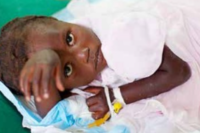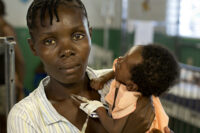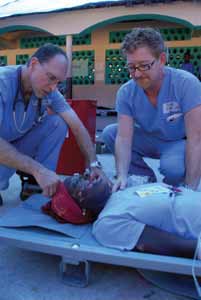 By Mark D. Pearlmutter, M.D., FACEP
By Mark D. Pearlmutter, M.D., FACEP
If there was any doubt that Milot was in need of an organized EMS system or that Hôpital Sacré Coeur was in need of an emergency department, we need only look back to the January 12th earthquake. While staff and volunteers worked tirelessly with limited resources and a seemingly endless influx of patients, it was for the most part a true ‘wing it’ operation. Transforming an adjacent school into a makeshift hospital almost overnight was truly remarkable. A truly chaotic situation was mitigated and the semblance of an organized ‘emergency department’ was established; replete with triage, acute treatment, pre-op, registration, holding, as well as discharge (transition in care) treatment areas. This was principally due to the timely arrival of emergency medicine physician and nurse volunteers that established an organized and relatively effective system of emergency care delivery at our most needed time. Each successive day witnessed an improvement in overall operations and logistics thanks to dedicated volunteers and our Haitian colleagues.
CRUDEM’s Vision Foreshadowed Haiti’s Great Need
Emergency Medicine is a non existent specialty in Haiti. It has been identified by the Ministry of Health and the country’s four medical schools as a key developmental need. Ironically, a year before the earthquake CRUDEM had a vision to create an emergency department at HSC and requested my assistance in its development. The earthquake served to fast track my personal involvement, under the umbrella of the Caritas Christi Health Care system, one of the first and largest healthcare systems to deploy personnel and resources to CRUDEM.
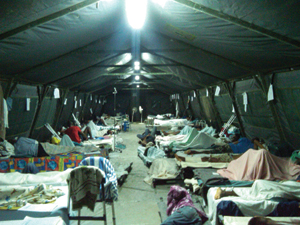 Enhancement of Emergency Care at Hôpital Sacré Coeur
Enhancement of Emergency Care at Hôpital Sacré Coeur
There are several components to enhancing emergency care at Hôpital Sacré Coeur. The first is establishing an emergency department where patients who arrive with acute injuries/illness can be properly triaged by dedicated ER nurses and then be evaluated by appropriate service specialists. This is not entirely dissimilar to how emergency medicine was practiced in the US prior to 1970. While the delivery of emergency care will initially require such a segregated service line our hope is that we eventually staff a specific emergency unit with a physician specifically trained in emergency medicine. The Emergency Medicine Seminar, which took place the last week of March, attracted twenty local physicians, many of whom were in their last year of medical training.
These physicians expressed a strong interest in serving as the future emergency physicians of Haiti.
EMS System Development
Integral to a hospital based emergency department is the establishment of an EMS system in and around Milot. Although HSC owns two ambulances that were put to great use during the earthquake, these are nothing more than transport vehicles with little if any basic resuscitation equipment or trained personnel. Last summer, I worked with Tufts Medical students to look at the feasibility of establishing a basic EMS system.
While this project remains in its ‘neonatal’ stage, at the end of March, together with Brian Connor, CEO and Ted White, Chief paramedic of LifeLine Ambulance, Tufts students spent an entire day teaching a first aid course to twenty five community health agents (CHA’s). Ideally having CHA’s serve as Emergency First Aid Responders (EFAR’s) coupled with HSC nursing backup will serve as the backbone for the development of a future pyramidal emergency
response system.
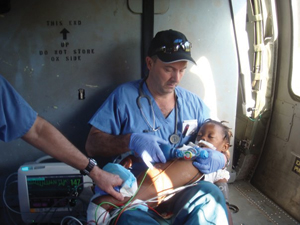 The first aid curriculum began the process of establishing basic algorithms for future “medical control.” Given the penetration of cell phone technology in and around Milot, the initial communication methodology will utilize a 911 text based communication. In such a system, those patients with a medical concern/illness/injury will text 911 to the local resource (CHA) with back up provided from an as yet to be established central resource (such as an HSC nurse).
The first aid curriculum began the process of establishing basic algorithms for future “medical control.” Given the penetration of cell phone technology in and around Milot, the initial communication methodology will utilize a 911 text based communication. In such a system, those patients with a medical concern/illness/injury will text 911 to the local resource (CHA) with back up provided from an as yet to be established central resource (such as an HSC nurse).
In this manner, calls can be triaged to determine if simple text based advice, a local site visit, or a fully equipped ambulance response to HSC would be necessary. Ultimately, this will evolve into a fully functional EMS system for Milot and eventually surrounding communities.
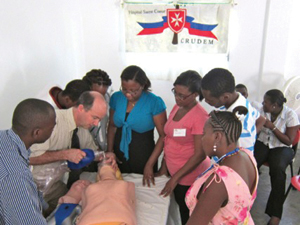 Hôpital Sacré Coeur Plans for Top Notch Disaster Management Program
Hôpital Sacré Coeur Plans for Top Notch Disaster Management Program
Unfortunately, Haiti has seen a number of tragedies over the past several years. While international aid is an essential component to large scale disasters world wide, those occurring in third world countries like Haiti require full scale outside assistance.
Nonetheless, training EMS personnel and emergency care providers in basic disaster management, inclusive of preparation, and incident command training will allow for a more integrated and collaborative approach to disaster management, which in the end can save thousands of lives. This will also be part of the future plans for the development of Emergency Care in Milot and HSC.
Several Tufts medical students will continue with these ambitious projects for an eight week period this coming summer. They will be overseen by a dozen Faculty advisors. Should anyone be interested in participating please feel free to contact me!
Mark Pearlmutter, M.D., FACEP is Chair and Vice President for Network Emergency Services, Caritas Christi Health Care, and Assistant Professor of Emergency Medicine at Tufts University School of Medicine. He received his Medical Degree from Tufts University School of Medicine and completed his residency at St. Elizabeth’s Medical Center in Boston. Dr. Pearlmutter has lead many volunteer medical teams to HSC and was one of the first responders after the earthquake of January, 2010.





